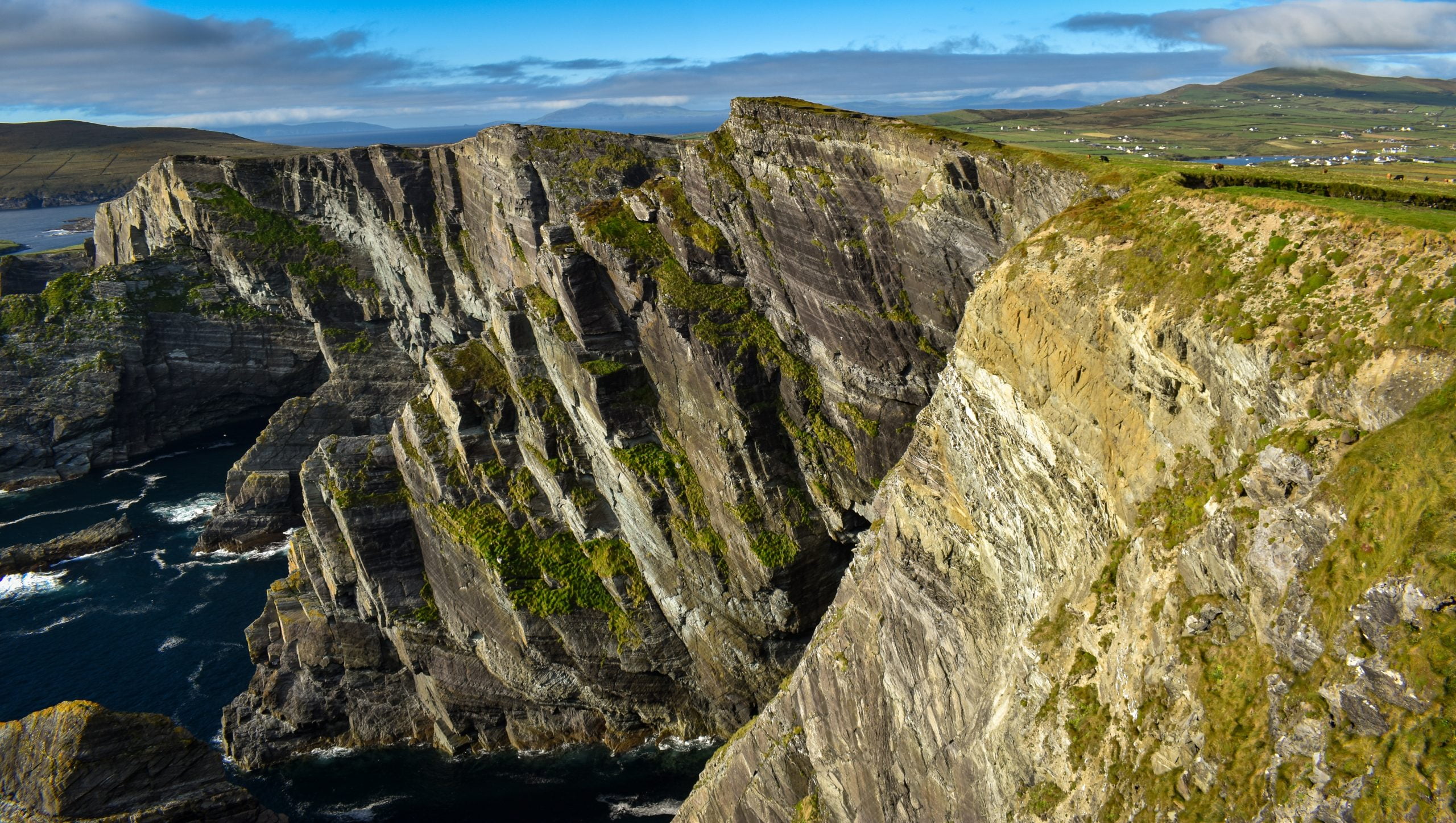This post may contain affiliate links, which means I’ll receive a commission if you purchase through my link, at no extra cost to you.
With sprawling green hills, waterfalls, dramatic cliffs, and a vibrant blue coastline, The Ring of Kerry is one of Ireland’s most popular scenic driving routes. Visitors can rent a car, take the tourist bus, or hire a private driver to explore The Ring of Kerry. I opted for renting a car which gave me the freedom to travel off the beaten path and take my time to explore each area.
The Ring of Kerry is approximately 120 miles long and stretches along small county roads. To prevent getting stuck behind the tourist buses, I drove clockwise. But a word of warning, because the roads are narrow, it can be daunting passing by the large buses.
The Gap of Dunloe

The most popular starting point for The Ring of Kerry is Killarney. The scenic drive begins at the Gap of Dunlue, a narrow mountain pass created during Ireland’s last ice age some 25,000 years ago. The result today is a carved-out valley with glacial lakes. Despite the fact that visitors can drive through the Gap of Dunlue, it is recommended to explore it by food. Take a walk along streams and fields of sheep from Kate Kearney’s Cottage, a family-run business that dates back 150 years. You may even be able to spot wild Japanese Sika deer from the narrow path. Walking the entire Gap, from Kate Kearney’s Cottage to Lord Brandon’s Cottage, takes up to 5 hours. I recommend at least walking to the Wishing Bridge, pinned on the map below.
The Gap of Dunloe route is a paved road, however, it is only wide enough for one vehicle, and signs leading up to the area request that non-residential vehicles refrain from driving the path. During peak season, visitors also have to share the road with horse carriages. The narrow winding path makes it difficult for drivers to avoid pedestrians, resident vehicles, and horse carriages, which is why it is highly recommended that visitors walk the path.
Cost: Free
Tip: Arrive early and you might just have the whole place to yourself!
Ross Castle

Ross Castle sits on the edge of Killarney’s lower lake, Lough Leane, and was built by O’Donoghue Mór in the 15th century. In time, the Castle was acquired by the Brownes, who became the Earls of Kenmare and owned large portions of what is now known as Killarney National Park.
Legend says that O’Donoghue, the original owner of Ross Castle, still lives in a deep slumber under the waters of Lough Leane. On the first morning of May, every seven years, he rises from the lake on his white horse and circles the lake. Anyone who catches a glimpse of him is said to have good fortune for the rest of their lives.
Cost: Free to walk outside of the castle.
Entry to Ross Castle: €5 Per Adult, €4 Per Senior, €3 for Children and Students, and €13 Per Family
Guided tours are required inside the castle, lasting roughly 45 minutes.
Muckross House

Muckross House, built in the 19th century, is situated near Muckross Lake, one of Killarney’s three lakes. The house was built for Henry Arthur Herbert and his wife, Mary. Construction of the building began in 1839 and was completed in 1843.
During the 1850s, the Herberts completed extensive garden work in preparation for Queen Victoria’s visit in 1861. The gardening tradition continued from then on. The Herbert family sold Muckross House in 1899 to Lord Ardilaun of the Guinness family who in turn sold it on to the Bowers Bourn family of California in 1910. In 1932 the house and gardens were donated to the Irish nation.
The Muckross Estate contains a Sunken Garden, Rock Garden, and the Stream Garden which was developed in the early 20th century by Lord and Lady Ardilaun.
Cost: Free to walk the grounds.
Entry to Muckross House: €7 Per Adult, €6 for Seniors, Children, and Students, Children Under 6 are Free
Torc Waterfall

Torc Waterfall is a short drive from Muckross House and is located at the base of Torc Mountain. The waterfall is 66 ft (20 m) high and 360 ft (110 m) long.
Water is supplied from a lake referred to as “Devil’s Punchbowl” lake. According to legend, a local man was cursed by the Devil. Each night he would transform into a wild boar, spending his evenings roaming the land near Torc Waterfall. Eventually, the man’s secret was revealed by a farmer which caused the man to burst into flames, disappearing into the Devil’s Punchbowl. “Toric” in Irish translates to boar. Despite its dark legend, Torc Waterfall is a striking cascade of water tucked within the Irish forest.
Cost: Free
Upper Lake Killarney

Along the N71 route, there is a pull-off to view Killarney Upper Lake. You can walk to the water’s edge from here, where I observed the fog lifting off the landscape, which created a dramatic, picturesque scene.
Cost: Free
Ladies View

Ladies View is a lookout point that was visited by Queen Victoria’s Ladies in Waiting who were part of her entourage during her visit to Killarney in 1861. The spot was named after them because of how taken they were with the view. There is a bar and restaurant at this viewpoint if you want a bite to eat, too!
Cost: Free
Molls Gap

A mountain pass named Molls Gap honors Molls Kissane, a woman who is credited with setting up a shebeen, an unlicensed bar, where she sold Irish moonshine, Poitín, to the men who built the original Kenmare to Killarney road in the 1820s. This viewpoint is located after several hairpin curves and also has a small cafe for guests.
Cost: Free
Staigue Stone Fort
Staigue is one of the largest stone forts in Ireland and is believed to have been built between 300 and 400 AD before Christianity came to Ireland. While it is unknown who the fort was built for, it’s clear that the family was extremely wealthy and required strong security. The wall measures over 19.5 ft (6 m) tall and 13 ft (4 m) thick in some areas, and surprisingly was built without any mortar.
Cost: €1 Trespass Fee Per Adult (Yes, you read that correctly). Children are free
Caroll’s Cove Pull-Off

Caroll’s Cove is a beautiful pull-off point that overlooks a Mediterranean-like beach when the sun is out!
Cost: Free
Derrynane Seashore Nature Trail

Derrynane Seashore Nature Trail is a hidden gem in my eyes because I only ran into locals here. Along the trail, visitors will find butterflies, toads, birds, and the chance to spot whales, dolphins, and sharks from the beachside. Horses seem to be popular on the trail too.
Cost: Free
Derrynane House and Gardens
Finish out the Derrynane Seashore Nature Trail with a stop at Derrynane House and Gardens, a National Monument that was once the home of an Irish politician and statesman.
Cost: Free to walk the grounds
Entry to Derrynane House: €5 Per Adult, €4 Per Senior, €3 Per Student, €13 Per Family
Ballinskelligs Castle
Ballinskelligs Castle, also known as McCarthy Mór Castle, was built in the 16th century and served as a protective tower from pirates along with a place to collect tariffs from trade ships. The tower was once 3 stories tall with walls over 6.5 ft (2 m) thick. The McCarthy Mór family built several of these towers around Cork and Kerry.
Cost: Free
Skelligs Telescope Viewpoint

The Skelligs Telescope Viewpoint falls on The Skellig Ring, an extension of The Ring of Kerry. Visitors can view the Skellig Islands right off the coast from this pull-off point with a free telescope. The Skellig Islands are two small and steep rocky islands that may look familiar and that’s because they appeared in several scenes in the 2015 Star Wars film, “The Force Awakens” and in the 2017 film, “The Last Jedi.”
The Skellig Islands are also famous for their gannet (seabirds) and puffin populations along with an early Christian monastery that is a UNESCO World Heritage Site, one of only three in Ireland. The smaller island is Little Skellig and holds Ireland’s largest and the world’s second-largest Northern Gannet colony, with nearly 30,000 pairs. About 1 m (1.5 km) east is Great Skelling. The monastic complex, also known as the Beehive Huts, has sat on this island since about the 6th century and illustrates the existence of the first Irish Christians. The islands are extremely well preserved and welcome a limited 180 visitors per day. Reservations fill up extremely fast, so reserve your spot several months ahead.
Cost: Free
Skelligs Chocolate and Cafe
This stop was recommended by my wonderful Bed & Breakfast hosts in Killarney and it did not disappoint! It is free to enter and with the open floor plan, the factory is completely visible to visitors. Best of all, there is a free sampling of their most popular chocolates. I still haven’t managed to find better chocolate! So fair warning, you might walk out with quite a few boxes of chocolate after your tasting!
Cost: Free
Kerry Cliffs

The Kerry Cliffs tower over the Atlantic Ocean with a shocking 1,000 ft drop (305 m) and offer the closest mainland viewing point to Skellig Islands. The cliffs were formed 400 million years ago when the area was a desert environment.
Kerry Cliffs surprisingly stand taller than the famous Cliffs of Moher which measures 702 ft (214 m). Compared to The Cliffs of Moher, Kerry Cliffs are a hidden gem. Visitors can take in the view without any crowds. From the entrance, it is roughly a 10-minute uphill walk to the stunning cliff views.
Cost: €5 Per Person (Cash Only)
Leacanabuaile and Cahergal Ring Forts
Leacanabuaile and Cahergal are stone forts located next to one another. Lecanabuaile is estimated to have been constructed in the 9th or 10th century to protect the farm of a wealthy landowner. The form is circular, with exterior walls measuring nearly 10 ft (3 m) thick.
Cahergall was constructed in the 7th century and is one of the best representations of stone forts in Ireland. The fort measures nearly 20 ft (6 m) tall and 10 ft (3 m) thick. Both forts offer 360-degree views of the vibrant green countryside along with the distant view of Ballycarbery Castle, a 16th-century castle.
Ballycarbery Castle is on private land but a car park 2 minutes from the Stone Forts allows visitors to appreciate the 500+-year-old construction from a short distance. The castle was home to the McCarthy Mor Clan.
Cost: No Fee
Mountain Stage Viewpoint
This road pull-off offers visitors 360-degree views, including the MacGillycuddy’s Reeks Mountains and the Atlantic Ocean. This viewpoint is a peaceful stop to take in nature and scenic views. This area also offers walking trails.
Cost: Free
Rossbeigh Beach Overlook
Rated as one of the best beaches in Kerry, Rossbeigh Beach stretches 7 miles on the Dingle Peninsula and is a great location for walking, swimming, and surfing.
Cost: Free
Final Thoughts
The Ring of Kerry drive is completely customizable – add as many stops as you want, both planned and unplanned. Because there is something beautiful around every corner, I recommend 2 to 3 days to truly enjoy this area of Ireland. Need a place to stay? I highly recommend Aghadoe View Bed & Breakfast in Killarney.
Map of Stops
myVEGAS Rewards Comp Calendars (August- December 2025)
Check out the 2025 myVegas Hotel Comp Calendars for Mandalay Bay, Luxor, Park MGM, MGM Grand, Excalibur, and New York New York, Bellagio, and Aria
Access to 360+ Gardens Across North America: American Horticultural Society Membership (2025)
Discover the wonders of nature through the American Horticultural Society’s (AHS) Reciprocal Admissions Program Membership, offering exclusive access to a remarkable network of over 360 gardens across North America, including 317 paid gardens with complimentary entry.
myVEGAS Rewards Comp Calendars (January – July 2025)
Check out the 2025 January – July myVegas Hotel Comp Calendars for Mandalay Bay, Luxor, Park MGM, MGM Grand, Excalibur, and New York New York, Bellagio, and Aria





Thanks for sharing! If I visit Ireland, I’ll be sure to do this drive. I love that you’ve shared so many stops and the cost. It looks like much of it can be done for free!
Thanks for sharing! I’m actually gonna save this for our trip when we plan for our Ireland trip!
Love this post! I would love to visit Ireland some day, and this would be great to do!
Wow, Ireland is an absolutely beautiful country. I can’t imagine how it’ll feel to see all that in real life.
I did this drive a few years ago and loved it.Can’t wait to do it again since it looks like I missed a things. Thanks for sharing!
So many great free things to do in Ireland! I can’t wait to plan a trip!